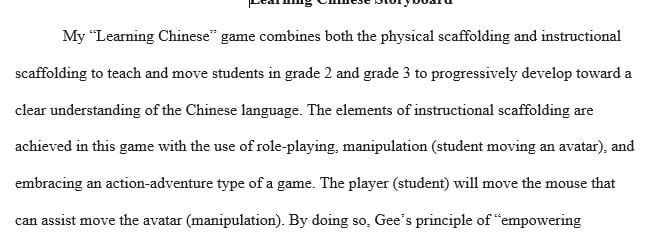How video games can inform educators through 13 core principles in three categories
Video Game Storyboard and 250 words
Introduction: In the following video, Professor Gee (ASU), former English professor, is talking about how video games can inform educators through 13 core principles in three categories: Empowered learners, problem-based learning, and deep understanding
After watching the video and visiting the UCI Arena you will create a storyboard (minimum of 6 frames) for a game to teach a topic that you struggled with in K-12 schooling using the principles. The storyboard can be based off of an existing game, or one of your own design
Step 1: Review the Gee’s Learning Principles and watch the videoJim Gee Principles on Gaming
Step 2: Create a storyboard (6 frames minimum) for a video game to teach a topic that you or other students struggled with in K-12 schooling using some of the principles discussed by Gee. You may create one with your group, or create your own. Your storyboard may be on paper or digital.
Step 3: Upload a photo to your blog along with a 250 word (or more) response to the following:
How will your video game include scaffolding?
How the video game you designed addresses the principles described by Gee (Empowering learners, Problem-based learning, Creating deep learning), be specific!
Example by Safa Abassy
My pizzeria game is especially useful for fourth and fifth graders who are learning about fractions. First, students will design their own avatar who will play the role of a pizza chef. Afterward, they will be able to name their pizzeria and create a slogan. This utilizes James Gee’s principle of “empowered learners” because students will try on a new identity and be more invested because they had a part in creating it. Users will feel like active agents in the game because they are creating pizzas with different toppings, which represent fractions. The game incorporates scaffolding by having a practice round in which users build their own pizza, become familiar with the various toppings, and see visuals of how a pizza reflects fractions. When the game actually begins, it will start with simple pizza orders and become more complex as the levels progress. The game acts as a sandbox for students to learn about fractions because there is no huge danger in them failing. The worst consequence is having their pizzeria’s star rating plummet, which means they would receive less money and tips. However, they are always able to repeat the level and boost their rating. As the levels advance, the game should grow more pleasantly frustrating, as customer demand increases. Furthermore, little challenges will occasionally pop up in which the user has to assume the role of a cashier. This adds more responsibility and helps them practice adding and subtracting decimals, another skill which is taught in that grade range.
Answer preview to how video games can inform educators through 13 core principles in three categories
APA
362 words



